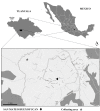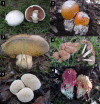The cultural significance of wild mushrooms in San Mateo Huexoyucan, Tlaxcala, Mexico
- PMID: 24597704
- PMCID: PMC3996006
- DOI: 10.1186/1746-4269-10-27
The cultural significance of wild mushrooms in San Mateo Huexoyucan, Tlaxcala, Mexico
Abstract
Background: We performed an ethnomycological study in a community in Tlaxcala, Central Mexico to identify the most important species of wild mushrooms growing in an oak forest, their significance criteria, and to validate the Cultural Significance Index (CSI).
Methods: Thirty-three mestizo individuals were randomly selected in San Mateo Huexoyucan and were asked seven questions based on criteria established by the CSI. Among the 49 mushroom species collected in the oak forest and open areas, 20 species were mentioned most often and were analyzed in more detail. Ordination and grouping techniques were used to determine the relationship between the cultural significance of the mushroom species, according to a perceived abundance index, frequency of use index, taste score appreciation index, multifunctional food index, knowledge transmission index, and health index.
Results: The mushrooms with highest CSI values were Agaricus campestris, Ramaria spp., Amanita aff. basii, Russula spp., Ustilago maydis, and Boletus variipes. These species were characterized by their good taste and were considered very nutritional. The species with the lowest cultural significance included Russula mexicana, Lycoperdon perlatum, and Strobylomyces strobilaceus. The ordination and grouping analyses identified four groups of mushrooms by their significance to the people of Huexoyucan. The most important variables that explained the grouping were the taste score appreciation index, health index, the knowledge transmission index, and the frequency of use index.
Conclusions: A. aff. basii and A. campestris were the most significant wild mushrooms to the people of San Mateo. The diversity of the Russula species and the variety of Amanita and Ramaria species used by these people was outstanding. Environments outside the forest also produced useful resources. The CSI used in Oaxaca was useful for determining the cultural significance of mushrooms in SMH, Tlaxcala. This list of mushrooms can be used in conservation proposals for the Quercus forests in the area.
Antecedentes: Con la finalidad de conocer las especies de hongos silvestres con mayor importancia cultural, para determinar los criterios de asignación de importancia, y para validar el índice de Significancia Cultural (ISC), se realizó un estudio en una comunidad de Tlaxcala, México.
Métodos: Se utilizaron siete variables incluidas en el ISC, las cuales se realizaron a 33 personas mestizas seleccionadas al azar en la comunidad de San Mateo Huexoyucan. Se seleccionaron 20 especies de hongos para determinar la importancia cultural. Se utilizaron técnicas de agrupación y de ordenación para conocer la relación entre la significancia cultural de los hongos, con base en el Índice de Abundancia Percibida, el Índice de Frecuencia de Uso, el Índice de Apreciación del Sabor, el Índice de Comida Multifuncional, el Índice de Transmisión del Conocimiento y el Índice de Salud.
Resultados: Los hongos que obtuvieron los valores más altos en el ISC fueron: Agaricus campestris, Ramaria spp., Amanita aff. basii, Russula spp., Ustilago maydis, and Boletus variipes. Son apreciados por su sabor, porque son considerados nutritivos y por ser buenos para la salud. Los análisis realizados mostraron cuatro grupos de especies con base en su importancia para las personas de Huexoyucan. Los criterios con mayor valor que se utilizan para la asignación de importancia son: el sabor, el beneficio en la salud, la transmisión del conocimiento y la frecuencia de uso.
Conclusiones: A. aff. basii and A. campestris fueron las especies de hongos más importantes para la gente de San Mateo; sin embargo, es sobresaliente la diversidad de especies de Russula, Amanita y Ramaria, que son utilizadas por las personas. Se observó la relevancia que tienen los ambientes fuera del bosque como productores de recursos útiles. Además, se confirmó la efectividad del ISC utilizado de manera previa en Oaxaca, para determinar la importancia Cultural en SMH, Tlaxcala. La lista de hongos obtenida puede ser de utilidad para apoyar propuestas de conservación del bosque de encino en el área estudiada.
Figures








References
-
- Hunn E. The utilitarian factor in folk biological classification. Am Anthropol. 1982;84:830–847. doi: 10.1525/aa.1982.84.4.02a00070. - DOI
-
- Stoffle RW, Halmo DB, Evans MJ. Puchuxwavaats vapi (To Know about Plants): traditional knowledge and the cultural significance of Southern Paiute plants. Hum Organ. 1999;58(4):416–429.
-
- Halmo DB, Stoffle RW, Evans MJ. Paitu Nanasuagaindu Pahonupi (Three Sacred Valleys): cultural Significance of Gosiute, Paiute, and Ute plants. Hum Organ. 1993;52(1):142–150.
-
- Berlin B, Breedlove DE, Laughlin RM, Raven PH. In: Meaning in Mayan Languages. Edmonson MS, editor. The Hague: Mouton; 1973. Cultural significance and lexical retention in tzeltal-tzotzil ethnobotany; pp. 143–164.
-
- Turner NJ. The Importance of a rose: evaluating the cultural significance of plants in Thompson and Lillooet interior Salish. Am Anthropol. 1988;90:272–290. doi: 10.1525/aa.1988.90.2.02a00020. - DOI
MeSH terms
LinkOut - more resources
Full Text Sources
Other Literature Sources
Miscellaneous

